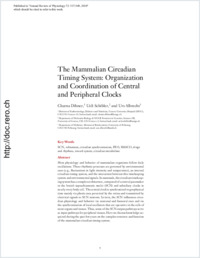The mammalian circadian timing system: organization and coordination of central and peripheral clocks
- Dibner, Charna Division of Endocrinology, Diabetes and Nutrition,HUG, Geneva, Switzerland
- Schibler, Ueli Department of Molecular Biology & NCCR Frontiers in Genetics, Sciences III, University of Geneva, Switzerland
- Albrecht, Urs Department of Medicine, Division of Biochemistry, University of Fribourg, Switzerland
-
2010
Published in:
- Annual Review of Physiology. - 2010, vol. 72, p. 517-549
English
Most physiology and behavior of mammalian organisms follow daily oscillations. These rhythmic processes are governed by environmental cues (e.g., fluctuations in light intensity and temperature), an internal circadian timing system, and the interaction between this timekeeping system and environmental signals. In mammals, the circadian timekeeping system has a complex architecture, composed of a central pacemaker in the brain's suprachiasmatic nuclei (SCN) and subsidiary clocks in nearly every body cell. The central clock is synchronized to geophysical time mainly via photic cues perceived by the retina and transmitted by electrical signals to SCN neurons. In turn, the SCN influences circadian physiology and behavior via neuronal and humoral cues and via the synchronization of local oscillators that are operative in the cells of most organs and tissues. Thus, some of the SCN output pathways serve as input pathways for peripheral tissues. Here we discuss knowledge acquired during the past few years on the complex structure and function of the mammalian circadian timing system.
- Faculty
- Faculté des sciences et de médecine
- Department
- Département de Biologie
- Language
-
- English
- Classification
- Biological sciences
- License
- License undefined
- Identifiers
-
- RERO DOC 17505
- DOI 10.1146/annurev-physiol-021909-135821
- Persistent URL
- https://folia.unifr.ch/unifr/documents/301554
Statistics
Document views: 598
File downloads:
- alb_mct.pdf: 2797
